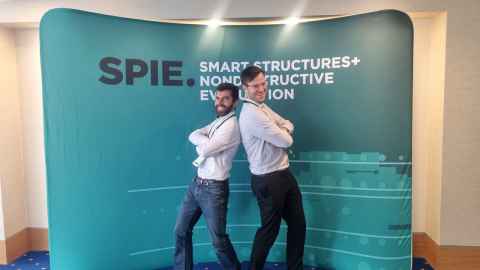Meet Taddy, a robot fish with muscle and smarts
24 April 2025
A motorless Kiwi robot fish, combining for the first time a bioengineering project around artificial muscles, and research into underwater sensors, has had its first swim – at a conference in Vancouver.

Taddy the Tadpole is powered not by a noisy motor, but by electroactive polymers - soft and flexible substances which move (like a muscle or a fin does) when activated by electrodes.
The fish-like quiet movement makes it ideal for spying on easily-frightened marine life – for research, of course.
At the same time, Taddy’s sensors detect the flow of the water around him, meaning he can change the way he swims depending on currents or wave patterns.

Robin Milward Cooney is one of two University of Auckland PhD students working at the Auckland Bioengineering Institute’s Biomimetics Lab and leading the robofish project. His work, funded by the Ministry of Business, Innovation and Employment, is on artificial muscles, which are basically two layers of polymer (“flexible stuff”) with liquid inside and propelled by an electric charge.
Milward Cooney’s ‘hasel’ artificial muscles (‘hydraulically amplified self-healing electrostatic’, for the initiated) make the robot fish swim. Meanwhile, electroactive polymer (EAP) sensors developed by the second Auckland Bioengineering Institute student, Arne Bruns, whose work is funded by the US Office of Naval Research, give it information from the movement of water around it to allow it to potentially swim better.
Bringing the technologies together for a live demonstration in front of about 100 experts at the annual SPIE Smart Structures conference in Vancouver has meant a “lot of 12-hour days” over the last couple of months, Milward Cooney says.
The pair wanted to test their robofish in New Zealand before taking it across the Pacific, but in the end didn’t have time.
“We flew to Vancouver and bought an aquarium. We had all the bits and pieces in the hotel room and there was a lot of adapting things to make it work.”

University of Auckland Professor Iain Anderson chairs the EAP-in-Action session at the annual SPIE Smart Structures conference in Vancouver and also heads the ABI Biomimetics Lab. Biomimetics is all about looking to nature to solve human engineering problems.
Anderson says the hands-on experience of bringing their research out of the lab and making something that actually works is hugely valuable for engineering students, as well as being a lot of fun.
“You have to find a way to solve problems with time pressures and very limited tools – it’s about using your brain and your creativity.”
The first annual EAP-in-Action day was held in the early 2000s and started as a robot-versus-human challenge. Research groups around the world competed to design a robotic arm made of EAP muscles that could defeat a human in an arm-wrestling match.
When it became clear humans were going to win for some time yet, the competition was expanded to allow researchers to demonstrate other EAP-related work.
This year’s crop included a Swiss team making artificial facial muscles for patients with paralysis, a “sensitive and tactile” human fingertip, and socks with coiled actuators designed to reduce swelling in people’s calves.

The session is also an opportunity to get research in front of people who might be interested in turning it into a product, Anderson says.
“You meet other people in the same field, and there are industry representatives – maybe someone from Boeing, or someone from GE – walking around to see what you’re up to.”
And Taddy - the first working robot fish with sensors to come out of the ABI depths? He spent about 15 minutes wagging his tail in his tank in Vancouver, Bruns says.
“We were very excited. It’s a major thing to bring these two technologies together and then carry our fish halfway around the world and get it working, even if only for a little while.”
Media contact
Nikki Mandow | Research communications
M: 021 174 3142
E: nikki.mandow@auckland.ac.nz